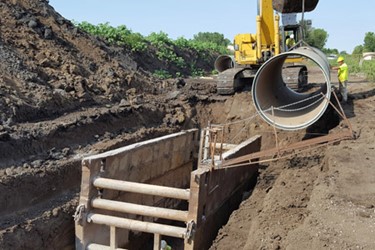Population And Reliable Infrastructure Grow Side By Side In Sioux Falls
By Erin Boudreaux, Hobas Pipe USA

Sioux Falls is the largest city in South Dakota and growing larger each day. In 2016, the city’s population increased by 5,200 people to a current population of 178,500 residents. A growing, thriving community needs its infrastructure to grow as well.
Since the first sewer was installed in the early 1890s, the Sioux Falls Water Reclamation Division has been investing in infrastructure, with the most recent projects costing $35 million and involving the reconstruction of the main sanitary sewer system, replacement of the Outfall Trunk Sewer, and the addition of the Main Pump Station Parallel Force Main. The Outfall Trunk Sewer carries wastewater to the Main Pump Station, which then pumps the wastewater to the city’s Water Reclamation facility.
The existing Outfall Trunk Sewer consists of two miles of 66-inch pipe. Built in the late 1970s, it is made of reinforced concrete pipe (RCP) with an asphalt/bituminous liner for corrosion protection. The Outfall Trunk Sewer conveys over 90 percent of the city’s wastewater and has become structurally weakened from sewer gases. Hydrogen sulfide (H2S) gas typically is formed in wastewater collection systems that are conducive to creating septic conditions. The deterioration of the liner was resulting in significant corrosion of the pipe.
Design Considerations
The City of Sioux Falls, along with their consultant, HDR Engineering, Inc.’s Sioux Falls office, investigated several options for replacement or rehabilitation of the line. Due to the conditions of the existing RCP pipe, extensive bypass pumping required, and the limited capacity for future development, relining with a cured-in-place pipe was not selected. “A thorough investigation of available sanitary sewer pipes was performed during the preliminary design of this project,” stated Dustin Posten, PE, Project Manager, City of Sioux Falls. “Considerations, amongst others, included lifecycle costs, corrosion resistance, constructability, operation and maintenance, compatibility with third party products, and longevity.” The city’s consultant recommended fiberglass reinforced pipe as the best overall material for this replacement project.
“The project was designed to relocate the new Outfall Trunk Sewer a distance away from the existing line,” stated Mark Cotter, PE, Director of Public Works, City of Sioux Falls. “The old line is essentially next to the Big Sioux River. As a result of this close proximity to the river, as the pipe and joints deteriorated and the river was running high, it would take on additional inflow/infiltration. For this reason we moved the new line as far from the river as we logistically could. The new alignment will also give us better access to the line in the future.” With limited access to the existing line, repairs were extremely limited. The old line will be decommissioned after the new outfall is put into service.
Reliable Replacement
Replacement of the Outfall Trunk Sewer consisted of approximately 9,700 linear feet of pipe. Hobas supplied 8,500 feet of 72-inch centrifugally cast, fiberglass reinforced, polymer mortar (CCFRPM) pipe that was installed by open cut. Included in the project was 505 feet of 72-inch CCFRPM jacking pipe that was utilized on two crossings; beneath Cliff Avenue and Interstate 229. The South Dakota Department of Transportation reviewed and approved the use of the installation method as well as the pipe materials. “The remaining length of pipe was smaller-diameter pipe connecting to the city’s equalization basins, and the installation of an additional siphon pipe under the Big Sioux River. There are several hundred additional feet of smaller diameter lateral connections as well,” stated Cotter.
After the pipe was installed, the required tests and inspections were performed. “Individual joint air tests were conducted at each individual joint to an air pressure of 3.5 pounds per square inch,” stated Posten. “A mandrel test was performed through the entire line to test for out-of-roundness or deflection after backfilling was complete. Finally, we performed a closed-circuit video inspection through the entire line as a final inspection for leaks or defects and to document pre-operation conditions.”
All tests were satisfactory, but the video inspection did reveal one joint that was leaking groundwater prior to being put in service. This joint was repaired in place by Hobas Field Services by injecting a grout product through the pipe wall on each side of the joint to stop the leak. Once the joint was sealed on the exterior, the interior side of the joint was filled with resin putty and sanded. Finally, fiberglass lamination sheets were layered over the joint and injection holes to completely seal the joint. Re-inspection found the joint to be water-tight.
Restoring Structural Integrity
The new 72-inch Outfall Trunk Sewer allows for continued population growth and increases the overall capacity of the city’s sewer system by approximately 21 MGD, which will reduce the risk of backups and sewer overflows. The new 72-inch Outfall project is the last phase of a major replacement project of the city’s main trunk sewer that included four separate segments of the Central Main and three separate segments of the Sioux River South Interceptor sewers along the Big Sioux River varying from 36- to 60-inch pipes. The construction timeframe took approximately 16 months from start to completion. The contractor, H&W Contracting, LLC, of Sioux Falls, has successfully completed numerous water main, sanitary sewer, and storm sewer projects for the City of Sioux Falls and surrounding municipalities in the four-state area.
The Sioux Falls Water Reclamation Division continues to develop and improve the city’s infrastructure. During 2016-2017, they completed a Water Reclamation and Collection System Master Plan that will assist the city with planning for the next 20 to 100 years.
